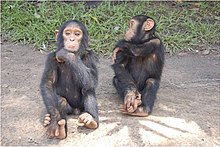The Chimpanzee Genome Project was an effort to determine the DNA sequence of the chimpanzee genome. Sequencing began in 2005 and by 2013 twenty-four individual chimpanzees had been sequenced. This project was folded into the Great Ape Genome Project.[1]

In 2013 high resolution sequences were published from each of the four recognized[2][3] chimpanzee subspecies: Central chimpanzee, Pan troglodytes troglodytes, 10 sequences; Western chimpanzee, Pan troglodytes verus, 6 sequences; Nigeria-Cameroon chimpanzee, Pan troglodytes ellioti, 4 sequences; and Eastern chimpanzee, Pan troglodytes schweinfurthii, 4 sequences. They were all sequenced to a mean of 25-fold coverage per individual.[1]
The research showed considerable genome diversity in chimpanzees with many population-specific traits. The central chimpanzees retain the highest diversity in the chimpanzee lineage, whereas the other subspecies demonstrate signs of population bottlenecks.[4]
- ^ a b Prado-Martinez, J.; et al. (2013). "Great ape genetic diversity and population history". Nature. 499 (7459): 471–475. Bibcode:2013Natur.499..471P. doi:10.1038/nature12228. PMC 3822165. PMID 23823723.

- ^ Groves, Colin P. (2001). Primate Taxonomy. Washington, DC: Smithsonian Institution Press. pp. 303–307. ISBN 978-1-56098-872-4.
- ^ Hof, J.; Sommer, V. (2010). Apes Like Us: Portraits of a Kinship. Mannheim: Panorama. p. 114. ISBN 978-3-89823-435-1.
- ^ de Manuel, M.; et al. (2016). "Chimpanzee genomic diversity reveals ancient admixture with bonobos". Science. 354 (6311): 477–48. Bibcode:2016Sci...354..477D. doi:10.1126/science.aag2602. PMC 5546212. PMID 27789843.